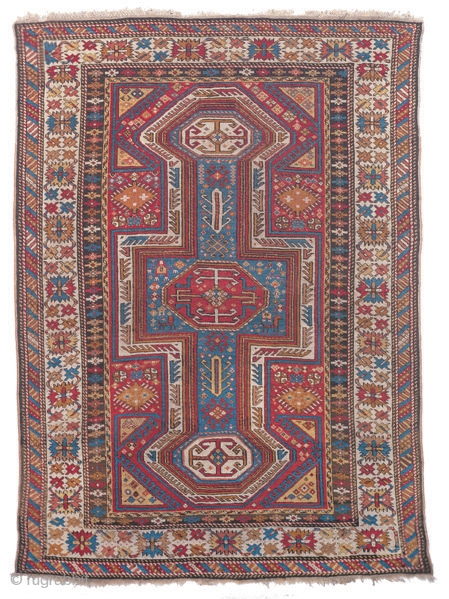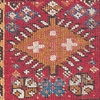Back
Rug with double keyhole design
Northeast Caucasus
Kuba area
circa 1850
151 x 108 cm (5’ x 3’7)
Alg 1048
symmetrically knotted wool pile on a wool foundation
Northeast Caucasus
Kuba area
circa 1850
151 x 108 cm (5’ x 3’7)
Alg 1048
symmetrically knotted wool pile on a wool foundation
Early Caucasian village rugs seem to be influenced either by a local tradition, which focuses on a silk embroidery iconography, or by the classical, Ottoman Turkish weaving language. Like the so-called Bellini Ushaks of the 16th century, the present rug shows a double keyhole pattern also seen on other Caucasian typologies such as the Sevan Kazaks and certain weavings from the Genje area. The highly depressed warps of this example are distinguishing features of the Kuba region, while the exquisite palette is typical of rugs woven in the pre-commercial period, closest to the middle of the 19th century.
http://www.albertolevi.com/default.asp?TL=ENG
price:
SOLD
- Home
- Antique Rugs by Region
- Category
- Profiles
- Post Items Free
- Albums
- Benaki Museum of Islamic Art
- Budapest: Ottoman Carpets
- Gulbenkian Museum
- Islamic Carpets. Brooklyn
- Islamic Textiles. Brooklyn
- Konya Museum: Rugs
- MKG, Hamburg
- MMA: Caucasian Carpets
- MMA: Mamluk Carpets
- MMA: Mughal Indian Carpets
- MMA: Ottoman Carpets
- MMA: Safavid Persian Carpets
- MMA: Turkmen Rugs
- McCoy Jones Kilims
- Ottoman textiles. Met
- Philadelphia Museum
- Rugs and Carpets: Berlin
- Seljuqs at the Met
- TIEM, Istanbul: Carpets
- V&A: Classical Carpets
- Vakiflar Carpets: Istanbul
- Baluch Rugs: Indianapolis
- Gallery Exhibitions
- Jaf an Exhibition
- Alberto Levi Gallery
- Andean Textile
- Christie's London: 2016
- Francesca Galloway
- HALI at 40
- ICOC Washington, DC 2018
- Jajims of the Shahsavan
- London Islamic Week April, 2018
- Mongolian Felts
- Navajo Rugs: JB Moore
- Persian Piled Weavings
- SF Tribal & Textile Art Show 2020
- SF Tribal 2019
- Sotheby's: C. Alexander
- Turkish Prayer Rugs
- Turkmen Main Carpets ICOC 2007










